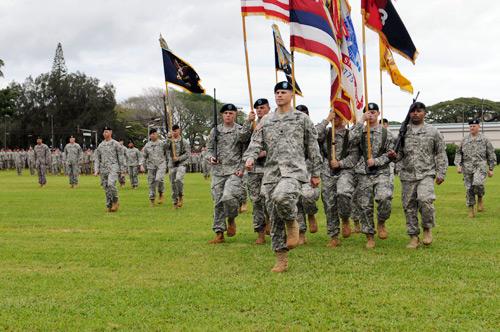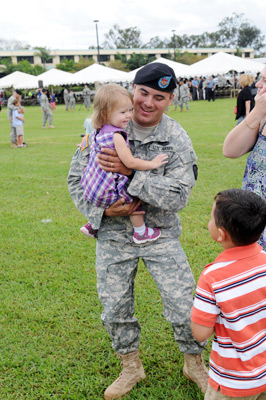‘Bronco’ brigade ready for tough duty

Lt. Col. Scott Naumann led the color guard during a deployment ceremony for the Bronco Brigade of the 3rd Infantry Brigade Combat Team, 25th Infantry Division, yesterday at Schofield Barracks' Sills Field. The brigade is deploying to Afghanistan.

Soldiers, family and guests of the 3rd "Bronco" Brigade Combat Team gathered yesterday at Sills Field at Schofield Barracks to bid farewell as the brigade prepares for a year of duty in Afghanistan.


A McKinley High and University of Hawaii graduate is about to lead 3,500 Schofield Barracks soldiers into a notoriously resistant and violent part of eastern Afghanistan, a region with some of the greatest individual battle losses of the 10-year-old war.
Col. Richard C. Kim, who took command of the 3rd "Bronco" Brigade Combat Team in May, said the Army has learned from past mistakes. Kim, 46, was born in South Korea and moved to Hawaii when he was about 8 years old.
"I feel very good about where we stand," Kim said. "We have known that we’re going to this region, and we have trained to get ready to go into this region."
A deployment ceremony was held yesterday on Schofield Barracks’ Sills Field as the 3rd Brigade prepares to start leaving later this month for a year of duty in Kunar, Nuristan and Nangarhar provinces on the border with Pakistan.
Five Pearl Harbor Navy SEALs and 14 other soldiers were killed in 2005 in a commando mission and subsequent crash of a rescue helicopter in Kunar that was shot down.
A July 13, 2008, firefight on the Kunar and Nuristan border in the village of Wanat resulted in deaths of nine soldiers with the Italian-based 173rd Airborne Brigade, including that of its platoon leader, 1st Lt. Jonathan P. Brostrom of Aiea.
Don't miss out on what's happening!
Stay in touch with breaking news, as it happens, conveniently in your email inbox. It's FREE!
On Oct. 3, 2009, meanwhile, 300 militants attacked Combat Outpost Keating near Kamdesh in Nuristan province. Eight Americans died.
The U.S. recently abandoned a strategy of placing small platoon-size elements in hard-to-defend remote valleys and ridges in favor of concentrating forces in population centers, and gone are many of the small and even larger outposts that once dotted the mountains.
"I don’t have the exact number of outposts there, but what I know is that there are quite a few that have been drawn down," Kim said.
Kim said the 3rd Brigade was tested in attacks like that in Wanat during recent exercises at the National Training Center in California. Companies of about 140 soldiers were set up in outposts in valleys and in the mountains and attacked during the drills by as many as 300 mock enemy fighters, he said.
"Every one of the leaders I talked to and the soldiers I talked to gained a tremendous appreciation and understanding of what are the things that they must do for them to be successful in that type of environment," Kim said.
In Afghanistan, Kim said units at smaller outposts will be placed in "dominating terrain" — not in valleys as in the past where a higher-up enemy had the upper hand.
David Brostrom, a retired Army colonel whose son, Jonathan, was killed in Wanat, said the U.S. has been slow to learn in a complex region of Afghanistan.
"I think the strategy for the most part never worked in those valleys," said Brostrom, who attended yesterday’s deployment ceremony. "I think we underestimated (the enemy). We didn’t understand the culture. It’s very tribal. They don’t like outsiders. We came in thinking they’d love Americans. They really didn’t love us. I don’t think they love the Taliban that much (either)."
Kim said his soldiers will be focusing on Jalalabad and Highway 7, which is along the famed Khyber Pass between Pakistan and Afghanistan, and runs to Kabul. The route to Kunar and the city of Asadabad also will be a focus, he said.
The 3rd Brigade will take over the region from the 1st Brigade Combat team of the 101st Airborne Division.
The Army recently published a story about a late fall firefight in the Watapur Valley of Kunar province and a soldier’s combat stress afterward.
"(The enemy) had low-crawled up, and they were bounding up onto our position trying to overrun us," said the soldier, Sgt. Kevin Garrison.
Rocket-propelled grenades were coming in, and bullets were flying in every direction. The soldier estimated that 200 enemy fighters were killed in the five-day operation.
Spc. Jamaal Cooper, 21, a Schofield soldier from Tallahassee, Fla., said yesterday that he was ready to head out on his first combat deployment.
"I’m excited," Cooper said. "I’ve known I’ve wanted to be in the Army since I was 5 years old."
Tara Smith was among the more than 1,000 people who turned out for the deployment ceremony. She was sitting in temporary bleachers with her daughter, Madison, 2, as her husband, Spc. Todd Smith, 25, stood at attention on the field, one of about 3,200 soldiers in formation.
"This is our first go-around," she said, meaning first combat deployment. Asked how she was doing, Smith said, "OK. Nervous. Scared. But I know that he’s going to be OK."
Lt. Gen. Benjamin R. "Randy" Mixon, head of the U.S. Army in the Pacific, said as the 3rd Brigade "cased" its battle flags for the deployment, "We’re reminded that the war is not over. You may think that by the media coverage, or the lack thereof, of what’s happening in Afghanistan, Iraq and the southern Philippines, that the war is over. But it is by no stretch over."




